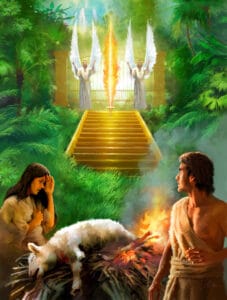Daily Lesson for Monday 12th of May 2025
As soon as our first parents were expelled from the Garden, God offered the hope of Messiah (Genesis 3:15). Then He established a powerful symbol at the gates of Eden: two cherubim with a brilliant flashing light between them. It should not be lost on us that this scene so closely resembles the ark of the covenant, a symbol of God’s throne (Exodus 25:18).
Read Genesis 3:21-24. What job were the cherubim tasked with—and why?
While the cherubim were certainly given the responsibility to keep sinners from accessing the tree of life (Genesis 3:22), they also were a symbol of hope, of promise, that one day humans would be restored to Paradise. “The Garden of Eden remained upon the earth long after man had become an outcast from its pleasant paths. The fallen race was long permitted to gaze upon the home of innocence, their entrance barred only by the watching angels. At the cherubim-guarded gate of Paradise the divine glory was revealed. Hither came Adam and his sons to worship God. Here they renewed their vows of obedience to that law the transgression of which had banished them from Eden. . . . But in the final restitution, when there shall be ‘a new heaven and a new earth’ (Revelation 21:1), it is to be restored more gloriously adorned than at the beginning.”—Ellen G. White, Patriarchs and Prophets, p. 62.
The wording in Genesis 3:24 is also interesting: the Bible indicates that God “placed” the cherubim to the east of Eden, and the original Hebrew word used is shakan, the root word for the sacred “tabernacle” (see Exodus 25:9, Numbers 3:26), where the presence of God dwelt among His people. Though the common term Shekinah, for the presence of God, does not appear in the Bible, it, too, is based on this word often translated “tabernacle.” A literal translation of shakan could read, “God tabernacled cherubim at the east of the Garden of Eden.”
In the Bible, cherubim are associated with the presence of God (see 1 Chronicles 13:6, Psalms 80:1, and Isaiah 37:16), in particular with His throne, which is the place where His name is proclaimed. We should not fail to notice that the 24 elders who attend God’s throne in Revelation 4:1-11 and 5 sing His praises and declare His right to rule as the One who created all things (Revelation 4:11). This can help us understand the throne room scene and our role as forgiven sinners in relationship to our Maker.
 (0)
(0)



